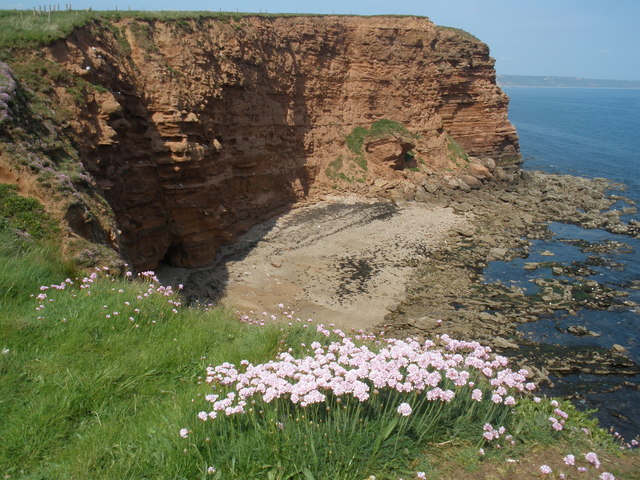Danger Point on:
[Wikipedia]
[Google]
[Amazon]
Danger Point is a coastal feature and cliff face in
 There are two rock sequences along the coast at Budleigh Salterton, the Pebble Beds and the "Otter Sandstone Formation". In the cliff face it is very apparent that both dip eastward. The "Budleigh Salterton Pebble Beds" are overlain by the sandstones that form the cliffs at Danger Point. Both sediments are markedly red, which indicates that they were formed in a desert in the hot dry climate of in the
There are two rock sequences along the coast at Budleigh Salterton, the Pebble Beds and the "Otter Sandstone Formation". In the cliff face it is very apparent that both dip eastward. The "Budleigh Salterton Pebble Beds" are overlain by the sandstones that form the cliffs at Danger Point. Both sediments are markedly red, which indicates that they were formed in a desert in the hot dry climate of in the
Devon
Devon ( ; historically also known as Devonshire , ) is a ceremonial county in South West England. It is bordered by the Bristol Channel to the north, Somerset and Dorset to the east, the English Channel to the south, and Cornwall to the west ...
, on the south coast of England
England is a Countries of the United Kingdom, country that is part of the United Kingdom. It is located on the island of Great Britain, of which it covers about 62%, and List of islands of England, more than 100 smaller adjacent islands. It ...
. It is about southeast of the city of Exeter
Exeter ( ) is a City status in the United Kingdom, cathedral city and the county town of Devon in South West England. It is situated on the River Exe, approximately northeast of Plymouth and southwest of Bristol.
In Roman Britain, Exeter w ...
and about east of Exmouth
Exmouth is a harbor, port town, civil parishes in England, civil parish and seaside resort situated on the east bank of the mouth of the River Exe, southeast of Exeter.
In 2011 it had a population of 34,432, making Exmouth the List of settl ...
and lies between the towns of Budleigh Salterton and Sidmouth
Sidmouth () is a town on the English Channel in Devon, South West England, southeast of Exeter. With a population of 13,258 in 2021, it is a tourist resort and a gateway to the Jurassic Coast World Heritage Site. A large part of the town has ...
.
Geology and littoral ecology
 There are two rock sequences along the coast at Budleigh Salterton, the Pebble Beds and the "Otter Sandstone Formation". In the cliff face it is very apparent that both dip eastward. The "Budleigh Salterton Pebble Beds" are overlain by the sandstones that form the cliffs at Danger Point. Both sediments are markedly red, which indicates that they were formed in a desert in the hot dry climate of in the
There are two rock sequences along the coast at Budleigh Salterton, the Pebble Beds and the "Otter Sandstone Formation". In the cliff face it is very apparent that both dip eastward. The "Budleigh Salterton Pebble Beds" are overlain by the sandstones that form the cliffs at Danger Point. Both sediments are markedly red, which indicates that they were formed in a desert in the hot dry climate of in the Triassic
The Triassic ( ; sometimes symbolized 🝈) is a geologic period and system which spans 50.5 million years from the end of the Permian Period 251.902 million years ago ( Mya), to the beginning of the Jurassic Period 201.4 Mya. The Triassic is t ...
Period about 225 million years ago.
The coastal path, south of the village of Otterton on the peninsula of Otter Sandstone, has many viewpoints and headlands from which the cliffs can be seen. However, there is no safe access to the seaward shore on any of the stretch between the southern tip near Danger Point to Ladram Bay in the north. The vertical cliffs are not interrupted (cut) by streams valleys, hence the lack of shore-access. To study the coast accurately a boat is required. It is possible to travel along the shore from the mouth of the Otter river to Ladram Bay near Otterton at very low tides but the beach is mostly covered with massive boulders of fallen sandstone, many very slippery because the more ferruginous nature of the rocks encourage algal growth. The embayments mean that there is always a risk of being cut off between headlands by even a slight rise in local sea level or weather conditions such as a wind blowing on shore. The most critical point is at Danger Point itself - hence its helpfully descriptive name! There are four other headlands which make this 4 km (3 mile) scramble continuously anxiety-provoking. However, the danger means the littoral ecology of the whole stretch is virtually untouched and very close to what can be inferred to be 'natural'. This includes impressively numerous gastropod populations with some unusually large specimens on show - (Patella spp & Littorina spp) and some red algae(such as Gigartina & Corallina ) which are fairly rare elsewhere on the south coast. There are some normal faults cutting the 100m cliffs further north closer to Ladram Bay and a lot of post-diagenetic mineralisation along joints, as well as some truncated coarse cross-bedding and what appear to be fossil levees seen in cross-section
Fossils from the Triassic period are extremely rare. Although normally only fossil fragments are found, the sandstones at Danger Point have yielded excellent discoveries, such as the Beaked Lizard, known as Rhynchosaur
Rhynchosaurs are a group of extinct herbivorous Triassic archosauromorph reptiles, belonging to the order Rhynchosauria. Members of the group are distinguished by their triangular skulls and elongated, beak like premaxillary bones. Rhynchosaurs ...
.
References
{{Jurassic Coast Bays of Devon Jurassic Coast Geology of Devon